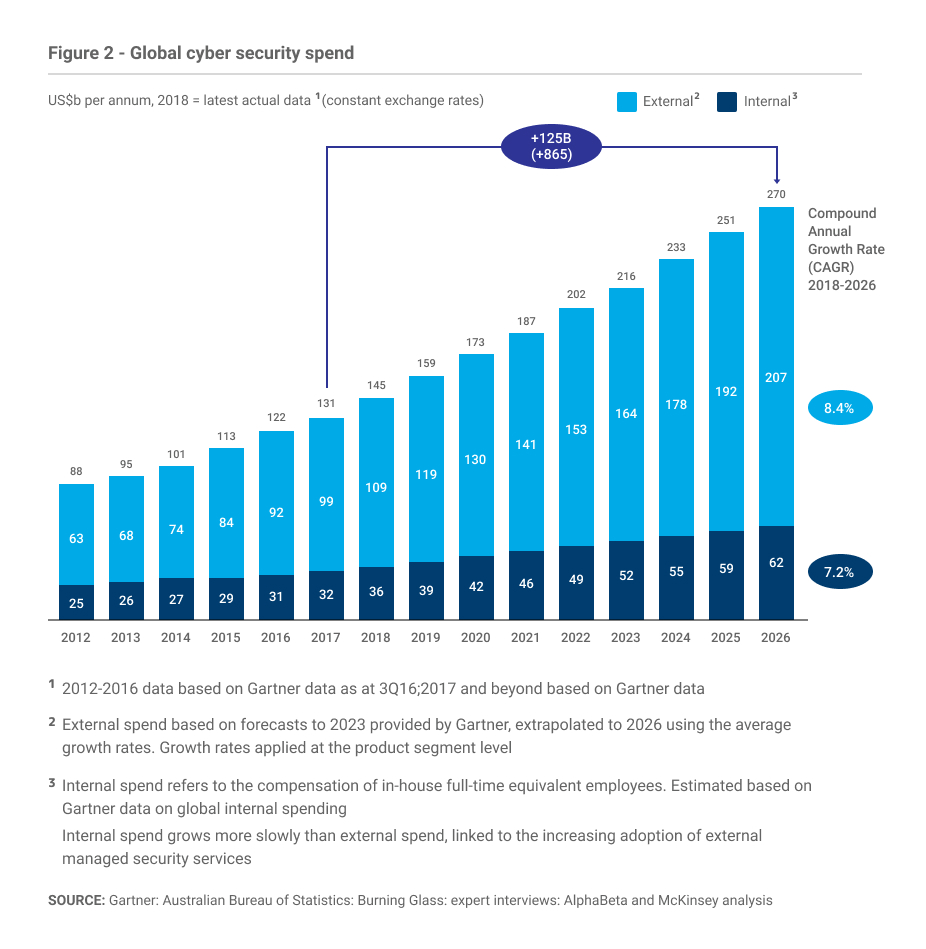AI In Cybersecurity: Building Smarter Defense for Your Data
Even though solutions for improving cybersecurity are advancing each day, cyber threats are also evolving to outsmart them. Conventional methods for malware detection need to be improved to combat the increasingly malicious threats and cybercriminals need to be constantly kept at bay as they try finding new ways to bypass the security programs and breach networks and systems with malware.
Businesses with digital platforms have always been susceptible to cyber-attacks and that has accelerated in recent times. In 2019, there were over 1500 data breaches and over 164 Million sensitive records exposed. In 2020, Twitter, Zoom, MGM Resorts, and Mariott witnessed significant cyber-attacks and data breaches this year. With 43% of all cyberattacks directed at small businesses, it’s more imperative for businesses to invest in stronger and smarter cybersecurity solutions. The global cybersecurity market is currently worth $173B in 2020, growing to $270B by 2026. By 2026, 77% of cybersecurity spending will be for externally managed security services. While the money spent on in-house or internal cybersecurity functions is expected to grow 7.2% each year to 2026, global spending on external cybersecurity products and services is projected to increase by 8.4% annually over the same period.

Source- Forbes
Artificial Intelligence (AI) is changing the nature of cybersecurity with its power to analyze massive volumes of data, detect user and activity patterns from it, identify anomalies, accelerate response times and augment security operations in the event of a threat.
How is AI helping businesses to respond to threats?
- Understand – AI can process billions of data points, both structured and unstructured. In a typical enterprise, this can be volumes of data related to user activity, application usage, network traffic, authentication and authorization data, and security data related to threats and attacks. Read our recent blog post about Dark Data, which summarizes the amount of data that organizations collect in their day-to-day activities. In addition to the internal data, external data such as common threats and vulnerabilities are regularly made available in Security Journals that can be tracked. AI can then be leveraged with Machine Learning, Natural Language Processing (NLP), and deep learning techniques, to “understand” vulnerabilities, identify anomalies, predict threats and risks to your business.
- Detect – Insights derived using AI help identify the patterns and relationships between threats, detect malicious files, suspicious IP addresses, or user activities. This analysis happens in real-time to allow security experts to respond faster and activate the defense mechanism. The key to a secure organization is the reaction time to security vulnerabilities and an organization’s ability to predict and prevent attacks.
- Enhance – AI can be leveraged to help an organization take an offensive position as opposed to a defensive position against threats and risks. Through continuous analysis of data for evaluating threats in a real-time manner and making the resulting intelligence accessible through a secure interface, organizations can develop threat monitoring systems that can help automate threat response and neutralize an attack in a time-sensitive manner.
Applications of AI in cybersecurity
- Vulnerability Management- Presently, the security solutions available in the market wait for the vulnerabilities in your technical environment to detect a threat and then take action. AI and ML-enabled cybersecurity will enable organizations to take a proactive approach to detect the vulnerabilities. AI analyzes the patterns to identify vulnerable areas.
- Secured Authentication – The traditional method of using a login id and password for authentication purposes is vulnerable to serious security risks. AI supports advanced biometric authentication methods including face recognition and iris recognition (by measuring the unique patterns in the colored circle of your eye) to verify and authenticate the identity of a user. AI in biometrics has massively strengthened the authentication system. An even more advanced version of authentication is Frictionless Authentication which is based on studying the user behavior and understanding the patterns that validate whether the user is who they say they are and provide access.
- Protection Against Phishing – Phishing, where an unsuspecting user is contacted by SMS, email, or telephone and lured into providing sensitive data such as banking and credit card details, and passwords, etc., is a common way cybercriminals access personal, sensitive, and financial information. This can be done on an individual basis with users or can be targeted towards an organization’s users, but the purpose of such an attack is to compromise the security of a user’s account and access sensitive information. As most phishing attacks use communication modes like emails and SMS, providers of those services have bolstered the anti-spam and anti-phishing technologies using NLP-based AI approaches to detect such content. However, software applications such as social networking apps, peer-peer networking apps are vulnerable to such malicious actors if proper precautions are not implemented. AI can help software application developers and businesses in implementing a real-time engine that can detect and eliminate phishing attacks against vulnerable users by constantly monitoring the traffic and communications between its members. Once detected, mitigation of such threats can be automated as well and such attacks serve as learning data for future threats.
- Responding to new threats – The traditional security methods use signature indicators from already encountered threats to detect threats. This technique is effective only with threats similar to ones that have already happened but not for newer types of cyber threats. AI can help you be prepared against potential new threats by analyzing the correlation between user behavior, organizational policies, network traffic, application security, and the risk of being open to new vulnerabilities.
Here are 3 telling stats from the Ponemon Institute’s 2018 Cost of a Data Breach 2018 study that tells how expensive a cyber attack can be on your business –
- Cost of the average data breach to companies worldwide: $3.86 million (U.S. dollars)
- Cost of the average data breach to a U.S. company: $7.91 million (U.S. dollars)
- The average time it takes to identify a data breach: 196 days
Protecting your data and systems becomes more important as we adopt newer technologies that collect data and build connected environments that are more vulnerable to cyber-attacks. It makes perfect sense to leverage AI to strengthen the cybersecurity of your business and protect your data, people, and brand reputation.


